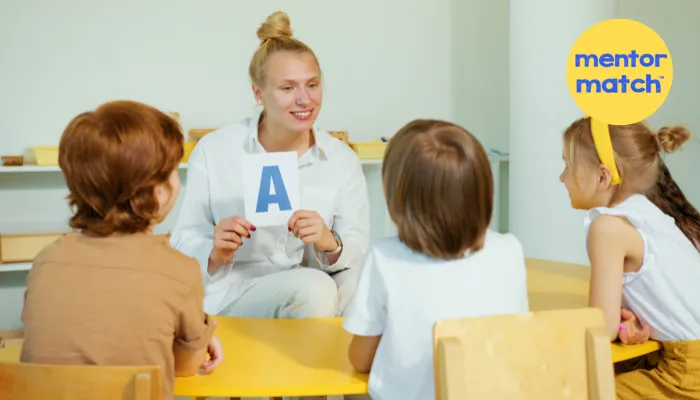
77.32% of parents see better grades in 3 months!
Imagine walking into your child's classroom and seeing students deeply engrossed in their lessons.
One student is working on a math problem using a tablet, another is collaborating with a small group on a science experiment, while a third is quietly journaling about their latest reading assignment.
No two kids are doing the exact same thing, yet every one of them is actively learning.
That’s the power of personalized instruction, it’s like tailoring a suit, but for learning. Every student gets a fit that's just right for them.
As parents, we all want our children to thrive in school, and personalized instruction promises to do just that.
But before you think it’s some kind of magic trick where each student gets their own mini-teacher, let’s break it down.
In this blog, we’ll dive deep into the real dimensions of personalized instruction.
Sounds interesting? Let’s jump in and explore how personalized instruction can revolutionize learning for K-12 students—while keeping it fun, engaging, and, most importantly, effective!
But First, What Makes Personalized Instruction Tick?

Personalized instruction doesn’t mean a completely customized curriculum for each child (because let’s face it, teachers are amazing, but they’re not wizards!).
Instead, it’s about meeting each child where they are, addressing their unique needs, while still keeping them connected to the larger classroom community.
We’ll bust some common myths (no, your child won’t just study their favorite subject all day!), explore the roles of teachers, parents, and even technology, and highlight how schools can create an environment where every child feels seen, supported, and challenged.
Also Read: Creating Personalized Learning Plans for K-12 Students
Strategies That Stick, Myths That Don’t
You’ve probably heard the buzz about personalized instruction: every child gets a unique learning experience, tailored just for them, and voila!—they're instantly thriving.
While that sounds fantastic, it’s not exactly how it works.
Personalized instruction doesn’t mean every student gets an entirely different curriculum
(imagine a teacher juggling 25 separate lesson plans!). Just the thought is exhausting!
Instead, it’s about using various strategies to meet the collective needs of a class while addressing individual differences.
A big misconception is that personalized instruction is synonymous with interest-based learning, but it’s more complex.
It’s about engaging kids through multiple avenues, catering to their interests while ensuring they’re exposed to a range of experiences.
So, yes, your budding mathematician might get to solve more complex problems, but they’ll still need to tackle some history along the way!
Team Work Makes The Dream Work!
Educators craft the magic, but they don’t act alone. Administrators play a crucial role in providing the tools and training necessary to implement personalized instruction, while parents offer support at home, ensuring students have the resources and mindset to thrive.
When everyone works together, personalized learning moves from theory to reality.
The Roadblocks In Personalized Instruction
Of course, implementation comes with hurdles.
Classroom size, limited resources, and varying student needs make it a bit like trying to cook a gourmet meal with just a handful of ingredients.
Still, with the right mindset and strategies, schools can overcome these barriers.
Clearing the Air: Myths About Personalized Instruction, Busted!
Let’s clear this up: personalized instruction is not about creating a one-of-a-kind curriculum for every student.
Think of it more like a buffet—you offer a variety of options, but everyone is still eating from the same table.
The teacher guides the students toward what they need most, but everyone is still learning similar skills and knowledge, just at their own pace or in different ways.
Interest-Based vs. Engaging Curricula: What Really Works?
One common misunderstanding is confusing personalized instruction with letting kids only learn what they love.
Sure, a child passionate about dinosaurs might get to explore paleontology as part of their science lesson, but personalized instruction goes beyond interests.
It’s about making the curriculum engaging for all learners, even if they’re not naturally inclined toward a subject.
You can’t skip math just because it’s not fun—sorry, kids!
The Shared Role of Educators and Students
This isn’t a solo journey.
Personalized instruction empowers students to take ownership of their learning, but they don’t do it alone.
Educators guide them along the way, providing scaffolding where needed and encouraging them to develop skills like critical thinking, collaboration, and problem-solving.
Leveraging Technology to Enhance, Not Replace, Human Connection
Technology plays a significant role in personalized instruction, but it’s not the star of the show.
After all, it’s all about blending technology with the personal touch that makes education meaningful.
Teachers still provide the necessary context, feedback, and emotional support that no algorithm can replace.
Focus on building genuine relationships and tailored support is what MentorMatch aims at, making sure every student feels valued and truly supported in their learning adventure.
Personalization Beyond Pixel
While technology helps, it’s crucial to ensure equity for all students.
Personalized instruction isn’t just about having the latest software or devices; it’s about making sure every student, regardless of background or resources, gets what they need to succeed.
It’s essential to strike a balance between digital and non-digital resources, ensuring no one is left behind.
Understanding the core elements of personalized instruction sets the stage for exploring its full potential.
While apps, software, and online platforms help tailor lessons, the human connection remains central.
Now, let’s dive into the Three Dimensions of Personalized Instruction, where we’ll uncover how these fundamental aspects come together to create a dynamic and effective learning experience.
Also Read: Online Tutoring for K-12 and Higher Education Students
The Three Dimensions of Personalized Instruction

To truly grasp the impact of personalized instruction, it helps to view it as a three-dimensional model.
This approach goes beyond individual student needs, embracing a collective mindset that allows for personalized yet equitable learning experiences.
The three dimensions:
- collective consciousness,
- small-group learning, and
- nurturing the inner dialogue
Provide a framework for effective personalized instruction. Each element plays a role in balancing individual needs with shared learning objectives.
Dimension 1: The Collective Consciousness
Here, in the table below we’ll dive into how building an inclusive classroom environment sets the stage for personalized learning.
Find out how making sure everyone feels valued and supported helps every student succeed.
Dimension 2: Small-Group Learning
Here, we’ll explore how small-group learning makes personalized instruction really effective.
Learn how forming flexible groups lets teachers give focused help, mix up peer interactions, and adjust as students grow.
With the right mix of groupings, every student gets the support they need to succeed.
Dimension 3: Nurturing the Inner Dialogue
In this dimension, we dive into how personal reflection and feedback can boost student growth.
Discover how giving thoughtful, individual feedback, holding regular one-on-one chats, and encouraging students to think about their progress and set goals can help them take charge of their own learning journey.
It’s all about making students feel empowered and motivated to succeed.
But remember, personalized instruction is not about each child learning entirely on their own—it’s about creating a collective learning environment where each student’s individual needs are met within a shared framework.
Parents, if you’re looking to enhance your child’s learning approach? Discover how MentorMatch can bring a personal touch to their education! Connect with our expert tutors who tailor their support to meet each student's unique needs.
Let’s wrap up with a final look at the key takeaways and reflect on how these strategies can transform education for the better.
Conclusion
And there you have it, your guide to mastering the dimensions of personalized instruction in K-12 education! We’ve explored the essentials, from creating a welcoming learning environment and fine-tuning small-group dynamics to nurturing personal growth through tailored feedback.
It's like assembling a high-tech gadget with all the right parts.
Remember, personalized instruction isn’t just about tweaking the lessons—it’s about ensuring that each student feels truly seen, supported, and inspired.
Feeling inspired to take your child’s personalized instruction to the next level? Mentor Match is here to help! Our expert tutors can bring that personal touch to your child’s educational approach, offering tailored support that aligns perfectly with their needs.
So, let’s not just aim for personalized instruction, let’s make it unforgettable.
After all, education should be a journey that,
every student loves,
learns from, and
looks forward to each day.



.png)
.webp)
.webp)